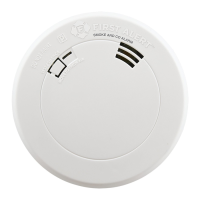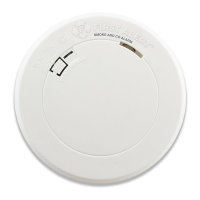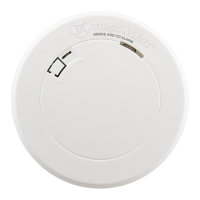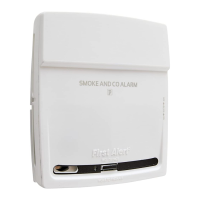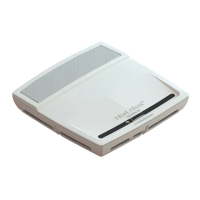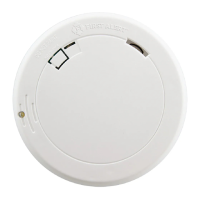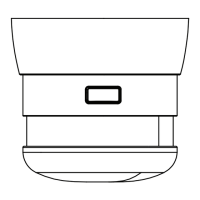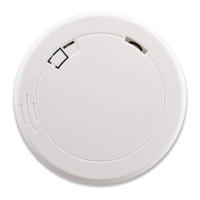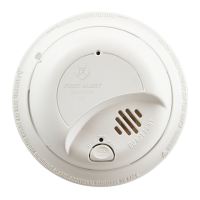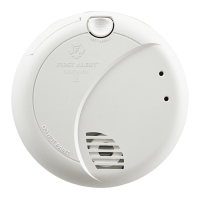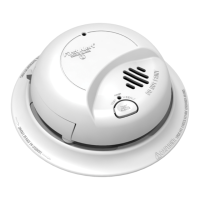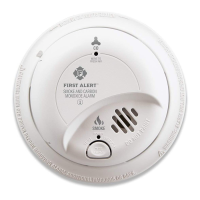USER’S MANUAL
COMBINATION CARBON MONOXIDE & SMOKE ALARM
IMPORTANT! PLEASE READ CAREFULLY AND SAVE.
The warnings/limitations card and manual contains important information about your Smoke & Carbon
Monoxide (CO) Alarm’s operation. If you are installing this Alarm for use by others, you must leave
this manual—or a copy of it—with the end user. Reference product card for additional information.
PARA EL MANUAL DEL USUARIO EN ESPAÑOL, POR FAVOR VISITE WWW.FIRSTALERT.COM.
Separate sensors to detect smoke and CO; the two
alarm systems work independently
Sealed-In Lithium Battery — Sealed-in lithium power supply; no
battery replacement required over the 10 year life of the alarm.
CONFORMS TO UL STD
217 AND UL STD 2034
Model PC1210
INTRODUCTION
All First Alert
®
and BRK
®
Smoke Alarms conform to regulatory requirements, including UL217 and are designed
to detect particles of combustion. Smoke particles of varying number and size are produced in all fires.
Ionization technology is generally more sensitive than photoelectric technology at detecting small particles, which
tend to be produced in greater amounts by flaming fires, which consume combustible materials rapidly and spread
quickly. Sources of these fires may include paper burning in a wastebasket, or a grease fire in the kitchen.
Photoelectric technology is generally more sensitive than ionization technology at detecting large particles,
which tend to be produced in greater amounts by smoldering fires, which may smolder for hours before
bursting into flame. Sources of these fires may include cigarettes burning in couches or bedding.
For maximum protection, use both types of Smoke Alarms on each level and in every bedroom of your home.
FIRE SAFETY TIPS
Follow safety rules and prevent hazardous situations: 1) Use smoking materials properly. Never smoke in bed. 2) Keep matches or lighters away from children; 3) Store flammable materials
in proper containers; 4) Keep electrical appliances in good condition and don’t overload electrical circuits; 5) Keep stoves, barbecue grills, fireplaces and chimneys grease- and debris-
free; 6) Never leave anything cooking on the stove unattended; 7) Keep portable heaters and open flames, like candles, away from flammable materials; 8) Don’t let rubbish accumulate.
Keep alarms clean, and test them weekly. Replace alarms immediately if they are not working properly. Smoke Alarms that do not work cannot alert you to a fire. Keep at least one working
fire extinguisher on every floor, and an additional one in the kitchen. Have fire escape ladders or other reliable means of escape from an upper floor in case stairs are blocked.
INSTALLATION
WHERE TO INSTALL THIS ALARM
Minimum coverage for Smoke Alarms, as recommended by the National Fire Protection Association (NFPA), is one Smoke Alarm on every floor, in every
sleeping area, and in every bedroom (See “Regulatory Information For Smoke Alarms” for details on the NFPA recommendations). For CO Alarms, the
National Fire Protection Association (NFPA) recommends that a CO Alarm should be centrally located outside of each separate sleeping area in the immediate
vicinity of the bedrooms. For added protection, install additional CO Alarms in each separate bedroom, and on every level of your home.
NOTE: For added protection, install an additional Smoke/CO Alarm at least 15 feet (4.6 meters) away from the furnace or fuel burning heat source where possible.
In smaller homes or in manufactured homes where this distance cannot be maintained, install the Alarm as far away as possible from the furnace or other fuel
burning source. Installing the Alarm closer than 15 feet (4.6 meters) will not harm the Alarm, but may increase the frequency of unwanted alarms.
In general, install combination Smoke and Carbon Monoxide Alarms:
•
On every level of your home, including finished attics and basements.
•
Inside every bedroom, especially if people sleep with the door partly or completely closed.
•
In the hall near every sleeping area. If your home has multiple sleeping areas, install a unit in each.If a hall is more than 40 feet (12 meters) long, install a unit at each end.
•
At the top of first-to-second floor stairs.
•
At the bottom of the basement stairs.
•
For additional coverage, install Alarms in all rooms, halls, and storage areas, where temperatures normally remain between 40˚ F and 100˚ F (4.4˚ C and 37.8˚ C).
© 2019 BRK Brands, Inc. All rights reserved. Distributed by BRK Brands, Inc. BRK Brands, Inc. is a subsidiary of Newell Brands Inc. (NASDAQ: NWL)
3901 Liberty Street, Aurora, IL 60504-8122
•
Customer Service Team: (800) 323-9005
•
www.firstalert.com
•
www.brkelectronics.com
06/19
•
Printed in Mexico
•
M08-0468-156403_WEB
Installed on Replace by
